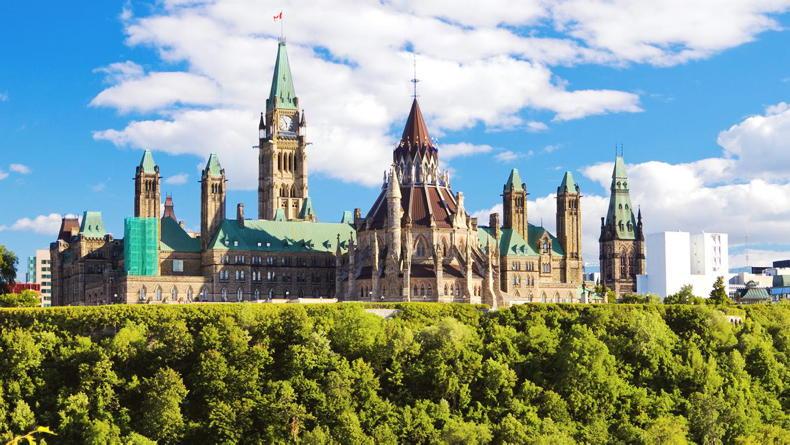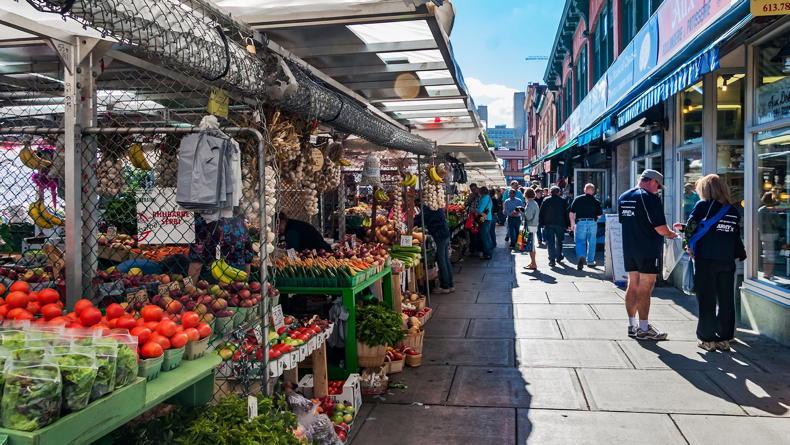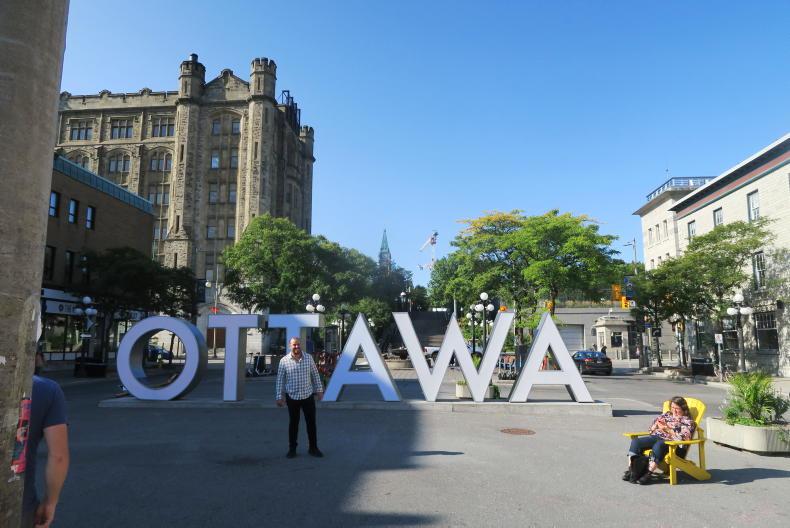‘In Ottawa, the past and present coexist like old friends sharing secrets,’ wrote historian Charlotte Gray, and she was definitely on to something. The blending of architectural styles from different eras is carried off with smoothness and charm.
The granite neoclassical Bank of Canada building is flanked by the mirrored facades of the 1970s Erickson Towers, which in turn reflect the imposing gothic revival Confederation Building on the other side of Wellington Street, and none of it jars on the visitor. The diverse yet harmonious architecture seems entirely fitting in a city that was carefully selected by Queen Victoria to be the capital of the Dominion of Canada. Montreal or Toronto would, then and now, have seemed more obvious choices, but the Queen was conscious of not being seen to favour either French-speaking Quebec or Anglophone Ontario.
A swift journey
I was wafted westward from Montreal to Ottawa on the smoothest of trains, on a morning when the sun was rising red-gold through pearly autumn mists and the forests of maple, oak and sumac were just coming into their fall glory. There can be few more pleasant ways to arrive in a new city.
Ottawa’s metro system, the O-Train, operates a single line which - like the Luas - has the charm of simplicity. I hopped on board for a few stops and alighted at ByWard Market, the lively downtown core of the city, full of open-air stalls, speciality food shops and quirky boutiques.

Parliament Buildings, Ottawa. / Liam Clancy
I ordered the Meat Lover’s Breakfast at Zak’s Diner and presently found myself in an epic man-versus-food contest with one of the largest meals I had ever eaten. I did not experience hunger again for about three days.
Cultural landmarks
The ByWard neighbourhood was the traditional focal point for Ottawa’s Catholic Irish and French communities who funded the construction of the grand Notre-Dame Cathedral in the mid-19th century. Directly across the street, behind Louise Bourgeois’ extraordinary 30-feet-high black spider sculpture, is the National Gallery of Canada, housed in a striking building of pink granite and glass.
The National Gallery stands on bluffs overlooking the broad Ottawa River, where the visitor’s eye is irresistibly drawn south to Parliament Hill, Ottawa’s crowning glory. ‘The Hill’ as it is colloquially known, is a rocky 164-foot escarpment on a bend of the river, home to a majestic suite of parliament and departmental buildings spread over 22ac.

Byward Market, Ottawa. / Liam Clancy
The architecture is neo-Gothic and stately. It looks like London’s Westminster transported to the wilderness.
Between the National Gallery and Parliament Hill is a deep gorge where the Rideau Canal climbs upwards from the river in a flight of eight locks. The 125-mile-long Rideau Canal, connecting the Ottawa and Saint Lawrence Rivers, is the oldest continuously operated canal system in North America. In the depths of Ottawa’s freezing winter, a five-mile section of the canal becomes the world’s largest skating rink and the focus of the annual Winterlude festival.
This was a difficult scene to picture as I strolled along the canalside path in the bright autumn sun, bound for the Canadian Museum of Nature. The museum is housed in the magnificent Victoria Memorial Museum Building. The interior is as fascinating as the exterior is splendid, with seven permanent exhibitions spread over four floors. It was one of the best museums of its kind that I have visited, and one could profitably pass an entire day there.
The Canadian War Museum, which opened in 2005, occupies a very different building; dramatic and unapologetically modern. A vast, echoing, dimly-lit lobby sets a fitting tone of austere reflection upon arrival, and from there the visitor can access galleries commemorating Canadian involvement in conflicts from colonial beginnings to the present day. Among the more obscure of those conflicts is the Battle of Ridgeway.
The Fenian Brotherhood, an Irish republican organization based in the United States, launched a series of quixotic raids into Canada in 1866, aimed at bringing pressure on the British government to withdraw from Ireland. The largest involved over 1,000 Fenians who crossed the Niagara River into Ontario on 1 June. Hastily assembled Canadian militia units marched to intercept them near Fort Erie, but were soundly trounced by the Fenians, most of whom were battle-hardened veterans of the American Civil War. The victorious raiders were unnerved by reports of approaching reinforcements and withdrew to the United States, and their efforts did not lead to the collapse of British rule in Ireland.
A lasting impression
The manner of my departure from Ottawa was markedly different to that of my arrival. Replete with culture, I made my way in the fading light to the Morisset Library, where I was to board a bus for Montreal. There was no bus – nor anything that could be described as a bus stop – at the library and my phone helpfully informed me that the last train for Montreal had already departed.

The signs of a great trip are all there. / Liam Clancy
Further urgent Googling revealed the existence of something called ‘Poparide’, a long-distance carpooling service that connects drivers and riders travelling between Canadian cities. Faced with no option more appealing, I set up an account on Poparide, entered the details of my proposed journey, and, to my relief, found a gentleman called Muhammad who was heading for Montreal that night. Muhammad’s profile indicated an entirely respectable person; a doctor perhaps, or a solicitor, so I was surprised when I found myself climbing into a dilapidated people carrier with him and an indeterminate number of fellow passengers, all conversing in various African languages.
We hurtled through the night at a speed suggestive of an attempt to break the sound barrier, with mad French dance music belting out of the radio and Muhammad providing the underlying rhythm by banging on the steering wheel with both hands.
This memorable service cost me a mere CA$30 (something like €20), and Muhammad and friends were as good-natured a group of people as I have ever shared a journey with. Canada’s capital is a city of many charms, and deserves to be visited, but on the whole, I would recommend that you take the train.
Air Canada and United Airlines operate flights from Dublin to Ottawa (change in Newark). There are also excellent rail connections from Montreal and Toronto.
Read more
Living Life: Vienna waits for you
Five days in Montreal: forget Paris
‘In Ottawa, the past and present coexist like old friends sharing secrets,’ wrote historian Charlotte Gray, and she was definitely on to something. The blending of architectural styles from different eras is carried off with smoothness and charm.
The granite neoclassical Bank of Canada building is flanked by the mirrored facades of the 1970s Erickson Towers, which in turn reflect the imposing gothic revival Confederation Building on the other side of Wellington Street, and none of it jars on the visitor. The diverse yet harmonious architecture seems entirely fitting in a city that was carefully selected by Queen Victoria to be the capital of the Dominion of Canada. Montreal or Toronto would, then and now, have seemed more obvious choices, but the Queen was conscious of not being seen to favour either French-speaking Quebec or Anglophone Ontario.
A swift journey
I was wafted westward from Montreal to Ottawa on the smoothest of trains, on a morning when the sun was rising red-gold through pearly autumn mists and the forests of maple, oak and sumac were just coming into their fall glory. There can be few more pleasant ways to arrive in a new city.
Ottawa’s metro system, the O-Train, operates a single line which - like the Luas - has the charm of simplicity. I hopped on board for a few stops and alighted at ByWard Market, the lively downtown core of the city, full of open-air stalls, speciality food shops and quirky boutiques.

Parliament Buildings, Ottawa. / Liam Clancy
I ordered the Meat Lover’s Breakfast at Zak’s Diner and presently found myself in an epic man-versus-food contest with one of the largest meals I had ever eaten. I did not experience hunger again for about three days.
Cultural landmarks
The ByWard neighbourhood was the traditional focal point for Ottawa’s Catholic Irish and French communities who funded the construction of the grand Notre-Dame Cathedral in the mid-19th century. Directly across the street, behind Louise Bourgeois’ extraordinary 30-feet-high black spider sculpture, is the National Gallery of Canada, housed in a striking building of pink granite and glass.
The National Gallery stands on bluffs overlooking the broad Ottawa River, where the visitor’s eye is irresistibly drawn south to Parliament Hill, Ottawa’s crowning glory. ‘The Hill’ as it is colloquially known, is a rocky 164-foot escarpment on a bend of the river, home to a majestic suite of parliament and departmental buildings spread over 22ac.

Byward Market, Ottawa. / Liam Clancy
The architecture is neo-Gothic and stately. It looks like London’s Westminster transported to the wilderness.
Between the National Gallery and Parliament Hill is a deep gorge where the Rideau Canal climbs upwards from the river in a flight of eight locks. The 125-mile-long Rideau Canal, connecting the Ottawa and Saint Lawrence Rivers, is the oldest continuously operated canal system in North America. In the depths of Ottawa’s freezing winter, a five-mile section of the canal becomes the world’s largest skating rink and the focus of the annual Winterlude festival.
This was a difficult scene to picture as I strolled along the canalside path in the bright autumn sun, bound for the Canadian Museum of Nature. The museum is housed in the magnificent Victoria Memorial Museum Building. The interior is as fascinating as the exterior is splendid, with seven permanent exhibitions spread over four floors. It was one of the best museums of its kind that I have visited, and one could profitably pass an entire day there.
The Canadian War Museum, which opened in 2005, occupies a very different building; dramatic and unapologetically modern. A vast, echoing, dimly-lit lobby sets a fitting tone of austere reflection upon arrival, and from there the visitor can access galleries commemorating Canadian involvement in conflicts from colonial beginnings to the present day. Among the more obscure of those conflicts is the Battle of Ridgeway.
The Fenian Brotherhood, an Irish republican organization based in the United States, launched a series of quixotic raids into Canada in 1866, aimed at bringing pressure on the British government to withdraw from Ireland. The largest involved over 1,000 Fenians who crossed the Niagara River into Ontario on 1 June. Hastily assembled Canadian militia units marched to intercept them near Fort Erie, but were soundly trounced by the Fenians, most of whom were battle-hardened veterans of the American Civil War. The victorious raiders were unnerved by reports of approaching reinforcements and withdrew to the United States, and their efforts did not lead to the collapse of British rule in Ireland.
A lasting impression
The manner of my departure from Ottawa was markedly different to that of my arrival. Replete with culture, I made my way in the fading light to the Morisset Library, where I was to board a bus for Montreal. There was no bus – nor anything that could be described as a bus stop – at the library and my phone helpfully informed me that the last train for Montreal had already departed.

The signs of a great trip are all there. / Liam Clancy
Further urgent Googling revealed the existence of something called ‘Poparide’, a long-distance carpooling service that connects drivers and riders travelling between Canadian cities. Faced with no option more appealing, I set up an account on Poparide, entered the details of my proposed journey, and, to my relief, found a gentleman called Muhammad who was heading for Montreal that night. Muhammad’s profile indicated an entirely respectable person; a doctor perhaps, or a solicitor, so I was surprised when I found myself climbing into a dilapidated people carrier with him and an indeterminate number of fellow passengers, all conversing in various African languages.
We hurtled through the night at a speed suggestive of an attempt to break the sound barrier, with mad French dance music belting out of the radio and Muhammad providing the underlying rhythm by banging on the steering wheel with both hands.
This memorable service cost me a mere CA$30 (something like €20), and Muhammad and friends were as good-natured a group of people as I have ever shared a journey with. Canada’s capital is a city of many charms, and deserves to be visited, but on the whole, I would recommend that you take the train.
Air Canada and United Airlines operate flights from Dublin to Ottawa (change in Newark). There are also excellent rail connections from Montreal and Toronto.
Read more
Living Life: Vienna waits for you
Five days in Montreal: forget Paris









 This is a subscriber-only article
This is a subscriber-only article










SHARING OPTIONS: